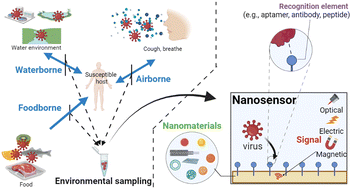Environmental routes of virus transmission and the application of nanomaterial-based sensors for virus detection
Abstract
Many outbreaks of emerging disease (e.g., avian influenza, SARS, MERS, Ebola, COVID-19) are caused by viruses. In addition to direct person-to-person transfer, the movement of these viruses through environmental matrices (water, air, and food) can further disease transmission. There is a pressing need for rapid and sensitive virus detection in environmental matrices. Nanomaterial-based sensors (nanosensors), which take advantage of the unique optical, electrical, or magnetic properties of nanomaterials, exhibit significant potential for environmental virus detection. Interactions between viruses and nanomaterials (or recognition agents on the nanomaterials) can induce detectable signals and provide rapid response times, high sensitivity, and high specificity. Facile and field-deployable operations can be envisioned due to the small size of the sensing elements. In this frontier review, we summarize virus transmission via environmental pathways and then comprehensively discuss recent applications of nanosensors to detect various viruses. This review provides guidelines for virus detection in the environment through the use of nanosensors as a tool to decrease environmental transmission of current and emerging diseases.

- This article is part of the themed collection: Environmental Science: Nano Recent Review Articles


 Please wait while we load your content...
Please wait while we load your content...
